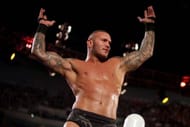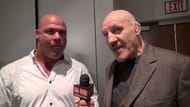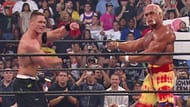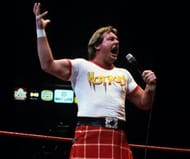By and large, like all of us in other professions and from every other conceivable walk of life, wrestlers are inevitably products of their respective generations. Meaning to say that the gimmick that a wrestler adopts on WWE programming is very much dependent on the unwritten rules that govern that specific ‘era’. Naturally we associate the edgy and the dark with the attitude era while the Hogan era was characterised by its cartoon-like programming. While the ruthless aggression era was more wrestling-centric, the PG era has, for all purposes, revisited the cartoonish feel of the Hogan era while curtailing other controversial performance elements such as blading.
But what if we could change up the formula? What if characters that were very much by-products of their times and were sculpted in certain ways to satiate the particular niche of their respective audience, could have a run in a completely different timeline? Let me elucidate. Events that transpire in the WWE are rarely singular – the inter-connectivity between events has been charted and mapped incessantly over the years. When the Kliq infamously broke Kayfabe at Madison Square Garden impending Nash and Hall’s ship-jump to WCW, the industry as a whole was irate. A livid Vince then withdrew the push Triple H was slated to receive. As a result Austin won the 1997 King of the Ring and the ensuing events since have been discussed to saturation.
Juxtaposing that with the recently concluded fatal fouraway event at Payback, yields stark contrast. In a moment that raised the roof off the arena, The Shield bretheren put aside their differences and worked together briefly to triple powerbomb Randy Orton through the announcers table. Despite being written into the story-line of the match in order to make the whole spot more believable, there was a fleeting moment, elementally quasi-Kayfabe, when the three of them celebrated together and it particularly drew a loud pop from the audience.
Gone are the days when Kayfabe was gospel and dictated the confines within which wrestlers pretty much lived their lives. Nowadays, the WWE programming itself flirts with the boundaries of Kayfabe constantly. Naturally then, with the ever-changing landscape of WWE programming over time, comes a point of interest – what if we could pick wrestler gimmicks and interchange their eras? Sounds fantastical? You might be surprised at how well some of them could have adapted.
Randy Orton in the Attitude Era
Indulge me in some hypothesizing. If only Randy Orton had been born perhaps 5 years earlier, might his WWE adventure have coincided with the Attitude Era? How much better would that have suited the Apex Predator than the PG era he, rather unfortunately, ended up performing in? Randy Orton is one of the most intense characters on WWE programming and few would argue when I say that heel Orton displays a mean streak that is too pronounced at times to be completely farcical.
The ‘punt kick’ to the head has been outlawed for being too dangerous but let’s face it – quite a few of his moves ranging from stinging uppercuts, to the DDT off the second rope to his immensely “over” finisher, the RKO, target the head region anyway. Couple that with a vindictive penchant for dishing out retribution, and one has to admit, Randy Orton’s character has all the ‘edge’ required to have succeeded as a top heel during the Attitude Era.
A feud between Randy Orton and The Rock could have been a mouth-watering prospect, owing to the natural third generation superstar dynamic there lay between the two to exploit. The Rock as a babyface and Randy Orton as a heel – come to think of it the WWE could still chance their arm over on this one in the future but purely for hypothetical reasons, this would have been one hell of a feud had it transpired during the Attitude Era.
Bruno Sammartino in the Ruthless Aggression Era
Bruno Sammartino has been immortalized in WWE lore for an iconic number that every wrestling fan knows – 4040. In the Madison Square Garden era of Vince McMahon Senior’s promotion, Sammartino reigned supreme, holding the championship gold in the longest recorded single reign till date. His second reign wasn’t too shabby either.
A master grappler, Sammartino captured the hearts of audiences and indeed, inspired a fair few wrestlers in what was a career as enriching in its longevity as it was in its integrity. As Triple H summarizes, the business stands to gain more by taking a step back and studying the fundamentals of wrestling that the old guard epitomized; wrestlers like Bruno Sammartino, Buddy Rodgers, Ric Flair and Superstar Billy Graham were less concerned with being a “highlight reel” and more so with the overall development of their persona.
Bruno’s well-known criticism of the WWE had to do with the plethora of shenanigans that inevitably attached themselves to pro-wrestling when the television became the main source for audience worldwide. TV ratings prescribed the necessity for crash TV; conversely Vince McMahon’s hand was forced.
However, the Ruthless Agression era that focused more on the in-ring action could have easily laid the landscape for Bruno to compete in. Considering that the mainstays of the era were technically superb wrestlers such as Kurt Angle, Chris Benoit, Eddie Guerrero and Brock Lesnar( although his power generally overshadows his wrestling ability, the man was a NCAA Champion), Sammartino might just have found this era of WWE programming more adept to his liking.Kurt Angle versus Bruno Sammartino has every marking of being a technical masterpiece, what with the chemistry and deep mutual respect that the two share in reality. One thing is for sure though; having been inspired by Bruno when he was young, it would certainly have been a dream-come-true match for Kurt Angle.
John Cena in the Golden/Hogan Era
This one requires no selling really; it’s a tailor-made instant fit. John Cena with his 6 moves of doom (including the springboard stunner) is viewed at times almost like a repackaged Hulk Hogan. It mandates discretion in making that generalization however, because the back stage reputation that Hogan gathered over his career is a far cry from ‘Everybody Loves Cena’ (except a very masculine majority of the audience.)
A compelling case however could be made that Cena would take to the Golden Era like fish to water, with it also being equally probable that he would have been featured as a cartoon character on Hulk Hogan’s Rock ‘n’ Wrestling. It’s not exactly hard to envision Cena’s multi coloured garb alongside the Hulkster’s yellow and red is it?
John Cena versus Hulk Hogan would have probably been the greatest spectacle for the under 9 age demographic that the WWE could ever hope to put together and we can go as far as saying that Cena might have been a through and through babyface in the Golden Era as opposed to the polarizing figure that he is today.
Hulk Hogan is a timeless legend; so much so that a blatant carbon copy of his persona still gets over with the fans today and despite the overt differences Cena’s gimmick might bear with Hogan’s, in essence, it still is very much a larger than life, super-hero type gimmick that may have found acceptance easier to come by in the 80s.
“Rowdy” Roddy Piper in the Reality Era
Roddy Piper was (and in all probability still is) one of the greatest wielders of a microphone to grace the landscape of the WWE. His critically acclaimed talk show, the Piper’s Pit, often featured the Rowdy One ripping into opponents verbally and how!
In the internet age, when believability sells more than a larger-than-life persona and amidst the blurred lines of Kayfabe, Roddy Piper would have been in his element. After all, believability was a trait that accompanied Piper throughout his legendary career.Roddy Piper figured out the fine line of balance between incorporating Crash TV into WWE programming and yet not allowing it to intrude on the integrity of the pro-wrestling aspect of the production. The Reality era would have provided the perfect backdrop for Piper to let fly and weekly episodes of the Piper’s pit could really have done no harm for the ratings.
Despite his career not being glittered with championship reigns that his anti-thesis Hulk Hogan enjoyed, Roddy Piper cemented his legendary status in the WWE thanks to his mercurial oratorical skills and his truculent personality. His contribution to the business was markedly distinct in an era surrounded by larger-than-life personas and childish programming, which brings me to the question – how well would Piper have done in the Reality Era?Just when you think you know the answer to that, you can be sure that Roddy Piper though, will change the question!
Dean Ambrose in the Attitude Era
As evidenced amply, Dean Ambrose is anything but the prototypical babyface. His shabby look is only further accentuated by his brawler style but he possesses energy and verve in abundance. His personality has caught on with the audience so much so that he has been singularly elevated to the WWE Title picture, with Roman Reigns merely settling for a bit-part role in proceedings.
Lately, the unpredictability of Ambrose has earned rave reviews and comparisons to a particular Superstar of note. In near Austin-esque fashion, Dean Ambrose gets arrested, and comes back in a police vehicle to get even with his boss(es). The WWE’s play on the similarities between the two are apparent for all to see which lends itself to the idea that Dean Ambrose would have been a handful, even in an all-action Attitude Era that featured stars aplenty.
The enthusiasm that Dean Ambrose displays for the business is one of the main reasons why the audience gravitate towards him, and given his fixation with ECW in his younger days, one can surmise that the chaos and anarchy that the Attitude Era entailed may have provided a scenario where Ambrose would not only have survived, but also thrived.
Couple that with the understated wit and humour that he evinces on the microphone with the ability to put on intense and interesting matches with just about anybody. Dean Ambrose then, one has to agree, is a Superstar who could have rubbed shoulders with the some of the biggest draws in the company in its most popular era.





